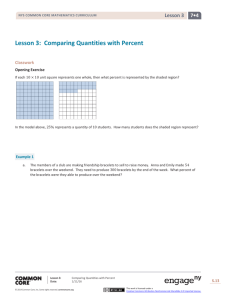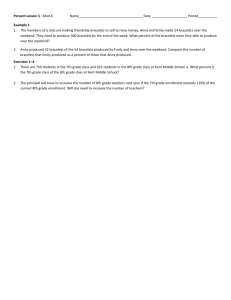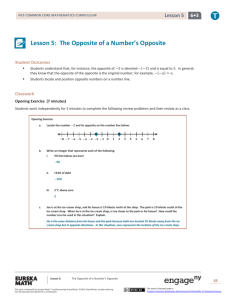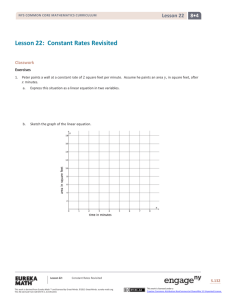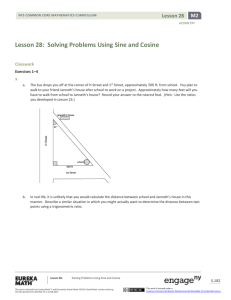Grade 7 Mathematics Module 4, Topic A, Lesson 3
advertisement
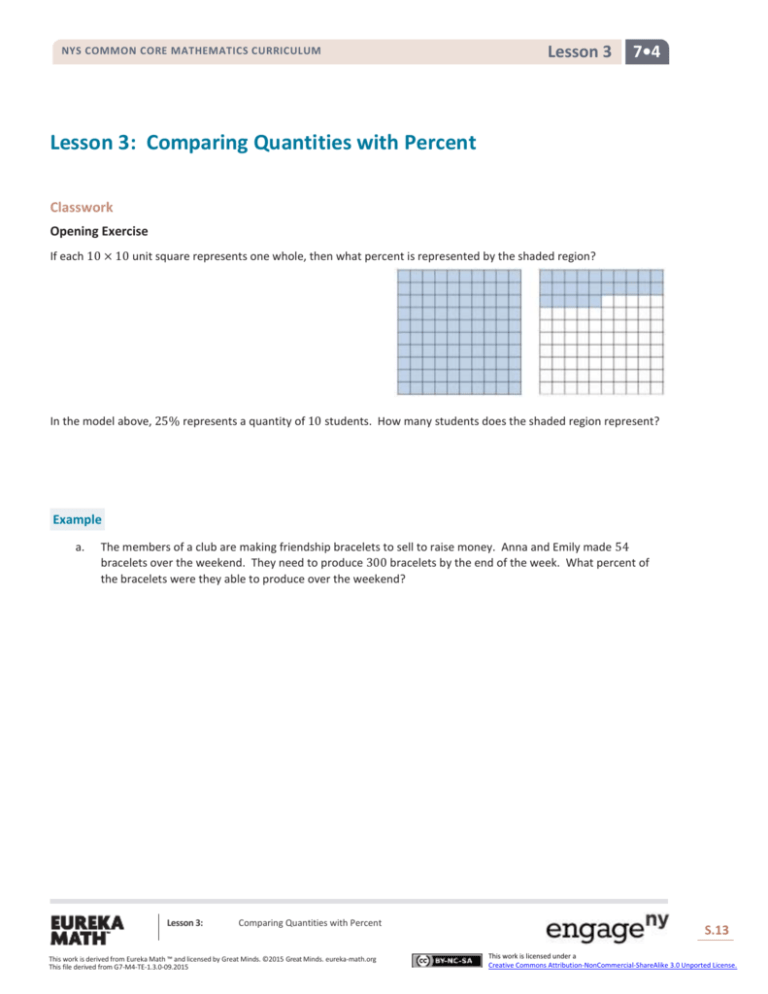
NYS COMMON CORE MATHEMATICS CURRICULUM Lesson 3 7•4 Lesson 3: Comparing Quantities with Percent Classwork Opening Exercise If each 10 × 10 unit square represents one whole, then what percent is represented by the shaded region? In the model above, 25% represents a quantity of 10 students. How many students does the shaded region represent? Example a. The members of a club are making friendship bracelets to sell to raise money. Anna and Emily made 54 bracelets over the weekend. They need to produce 300 bracelets by the end of the week. What percent of the bracelets were they able to produce over the weekend? Lesson 3: Comparing Quantities with Percent This work is derived from Eureka Math ™ and licensed by Great Minds. ©2015 Great Minds. eureka-math.org This file derived from G7-M4-TE-1.3.0-09.2015 S.13 This work is licensed under a Creative Commons Attribution-NonCommercial-ShareAlike 3.0 Unported License. NYS COMMON CORE MATHEMATICS CURRICULUM Lesson 3 7•4 b. Anna produced 32 bracelets of the 54 bracelets produced by Emily and Anna over the weekend. Write the number of bracelets that Emily produced as a percent of those that Anna produced. c. Write the number of bracelets that Anna produced as a percent of those that Emily produced. Exercises 1. There are 750 students in the seventh-grade class and 625 students in the eighth-grade class at Kent Middle School. a. What percent is the seventh-grade class of the eighth-grade class at Kent Middle School? b. The principal will have to increase the number of eighth-grade teachers next year if the seventh-grade enrollment exceeds 110% of the current eighth-grade enrollment. Will she need to increase the number of teachers? Explain your reasoning. Lesson 3: Comparing Quantities with Percent This work is derived from Eureka Math ™ and licensed by Great Minds. ©2015 Great Minds. eureka-math.org This file derived from G7-M4-TE-1.3.0-09.2015 S.14 This work is licensed under a Creative Commons Attribution-NonCommercial-ShareAlike 3.0 Unported License. NYS COMMON CORE MATHEMATICS CURRICULUM Lesson 3 7•4 2. At Kent Middle School, there are 104 students in the band and 80 students in the choir. What percent of the number of students in the choir is the number of students in the band? 3. At Kent Middle School, breakfast costs $1.25 and lunch costs $3.75. What percent of the cost of lunch is the cost of breakfast? 4. Describe a real-world situation that could be modeled using the equation 398.4 = 0.83(𝑥). Describe how the elements of the equation correspond with the real-world quantities in your problem. Then, solve your problem. Lesson 3: Comparing Quantities with Percent This work is derived from Eureka Math ™ and licensed by Great Minds. ©2015 Great Minds. eureka-math.org This file derived from G7-M4-TE-1.3.0-09.2015 S.15 This work is licensed under a Creative Commons Attribution-NonCommercial-ShareAlike 3.0 Unported License. Lesson 3 NYS COMMON CORE MATHEMATICS CURRICULUM 7•4 Lesson Summary Visual models or arithmetic methods can be used to solve problems that compare quantities with percents. Equations can be used to solve percent problems using the basic equation Quantity = Percent × Whole. Quantity in the new percent formula is the equivalent of part in the original percent formula. Problem Set 1. 2. Solve each problem using an equation. a. 49.5 is what percent of 33? b. 72 is what percent of 180? c. What percent of 80 is 90? This year, Benny is 12 years old, and his mom is 48 years old. a. What percent of his mom’s age is Benny’s age? b. What percent of Benny’s age is his mom’s age? c. In two years, what percent of his age will Benny’s mom’s age be at that time? d. In 10 years, what percent will Benny’s mom’s age be of his age? e. In how many years will Benny be 50% of his mom’s age? f. As Benny and his mom get older, Benny thinks that the percent of difference between their ages will decrease as well. Do you agree or disagree? Explain your reasoning. 3. This year, Benny is 12 years old. His brother Lenny’s age is 175% of Benny’s age. How old is Lenny? 4. When Benny’s sister Penny is 24, Benny’s age will be 125% of her age. 5. a. How old will Benny be then? b. If Benny is 12 years old now, how old is Penny now? Explain your reasoning. Benny’s age is currently 200% of his sister Jenny’s age. What percent of Benny’s age will Jenny’s age be in 4 years? Lesson 3: Comparing Quantities with Percent This work is derived from Eureka Math ™ and licensed by Great Minds. ©2015 Great Minds. eureka-math.org This file derived from G7-M4-TE-1.3.0-09.2015 S.16 This work is licensed under a Creative Commons Attribution-NonCommercial-ShareAlike 3.0 Unported License. Lesson 3 NYS COMMON CORE MATHEMATICS CURRICULUM 6. At an animal shelter, there are 15 dogs, 12 cats, 3 snakes, and 5 parakeets. a. What percent of the number of cats is the number of dogs? b. What percent of the number of cats is the number of snakes? c. What percent less parakeets are there than dogs? d. Which animal has 80% of the number of another animal? e. Which animal makes up approximately 14% of the animals in the shelter? 7. Is 2 hours and 30 minutes more or less than 10% of a day? Explain your answer. 8. A club’s membership increased from 25 to 30 members. 9. 7•4 a. Express the new membership as a percent of the old membership. b. Express the old membership as a percent of the new membership. The number of boys in a school is 120% the number of girls at the school. a. Find the number of boys if there are 320 girls. b. Find the number of girls if there are 360 boys. 10. The price of a bicycle was increased from $300 to $450. a. What percent of the original price is the increased price? b. What percent of the increased price is the original price? 11. The population of Appleton is 175% of the population of Cherryton. a. Find the population in Appleton if the population in Cherryton is 4,000 people. b. Find the population in Cherryton if the population in Appleton is 10,500 people. Lesson 3: Comparing Quantities with Percent This work is derived from Eureka Math ™ and licensed by Great Minds. ©2015 Great Minds. eureka-math.org This file derived from G7-M4-TE-1.3.0-09.2015 S.17 This work is licensed under a Creative Commons Attribution-NonCommercial-ShareAlike 3.0 Unported License. Lesson 3 NYS COMMON CORE MATHEMATICS CURRICULUM 7•4 12. A statistics class collected data regarding the number of boys and the number of girls in each classroom at their school during homeroom. Some of their results are shown in the table below. a. Complete the blank cells of the table using your knowledge about percent. Number of Boys (𝒙) Number of Girls (𝒚) 𝟏𝟎 5 1 𝟏𝟖 12 𝟓 10 Number of Girls as a Percent of the Number of Boys 25% 𝟒 50% 𝟐𝟎 90% 10 250% 6 60% 𝟏𝟏 200% 5 𝟏𝟓 20% 15 𝟔 18 𝟐𝟓 10 𝟏𝟎 75% 110% 2 𝟏𝟔 10% 75% 7 𝟑 𝟏𝟐 1 33 % 3 50% 200% 10 b. Using a coordinate plane and grid paper, locate and label the points representing the ordered pairs (𝑥, 𝑦). c. Locate all points on the graph that would represent classrooms in which the number of girls 𝑦 is 100% of the number of boys 𝑥. Describe the pattern that these points make. Lesson 3: Comparing Quantities with Percent This work is derived from Eureka Math ™ and licensed by Great Minds. ©2015 Great Minds. eureka-math.org This file derived from G7-M4-TE-1.3.0-09.2015 S.18 This work is licensed under a Creative Commons Attribution-NonCommercial-ShareAlike 3.0 Unported License. NYS COMMON CORE MATHEMATICS CURRICULUM Lesson 3 7•4 d. Which points represent the classrooms in which the number of girls as a percent of the number of boys is greater than 100%? Which points represent the classrooms in which the number of girls as a percent of the number of boys is less than 100%? Describe the locations of the points in relation to the points in part (c). e. Find three ordered pairs from your table representing classrooms where the number of girls is the same percent of the number of boys. Do these points represent a proportional relationship? Explain your reasoning. f. Show the relationship(s) from part (e) on the graph, and label them with the corresponding equation(s). g. What is the constant of proportionality in your equation(s), and what does it tell us about the number of girls and the number of boys at each point on the graph that represents it? What does the constant of proportionality represent in the table in part (a)? Lesson 3: Comparing Quantities with Percent This work is derived from Eureka Math ™ and licensed by Great Minds. ©2015 Great Minds. eureka-math.org This file derived from G7-M4-TE-1.3.0-09.2015 S.19 This work is licensed under a Creative Commons Attribution-NonCommercial-ShareAlike 3.0 Unported License.

